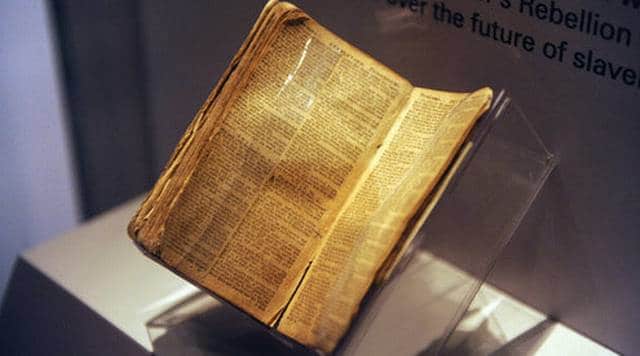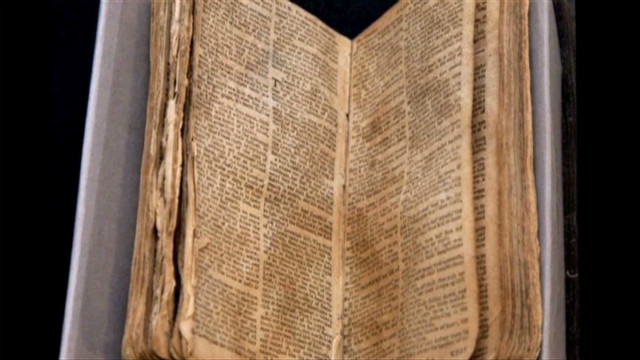Nat Turner’s Bible was donated to the Smithsonian in Washington DC by a family with Southampton County roots. The Bible, which he is believed to have been holding when captured, now serves as a centerpiece at the National Museum of African American History. Wendy Porter of Virginia Beach spoke of giving the Bible to the National Museum of African American History and Culture, “We just thought it had so much history and there’s so much bloodshed on it”.
Turner, an educated minister and slave believed he was divinely chosen to lead his people out of slavery
led what is believed to be the bloodiest slave revolts in American history. On August 21, 1831 Turner initiated the uprising by killing his owner, Joseph Travis, and Travis’ family. Within just two days, an estimated 60 whites had been murdered and the group of slaves participating in the uprising had swelled to more than 60. In the rebellion’s aftermath, more than 200 enslaved and free blacks were executed.

Turner eluded capture for two months but was later found in a hole hidden by fence rails. He was immediately arrested. Two months that Turner was on the run was enough time for the rebellion to generate national attention and panic throughout the South. Six days after conviction, Turner was hanged, and his body mutilated. After Turner’s death, the judge ordered the Commonwealth to reimburse the estate belonging to Turner’s master. Considered as confiscated chattel, Nat Turner’s life was valued at just $375.
Maurice Pearson, a resident of Virginia Beach, heard the Bible belonged to Turner. Person’s father took possession of the Bible in 1912 when the Courthouse in Southampton was being renovated. “They had a bunch of things they didn’t want, and he took the Bible since he belonged to the Church”, said Person. The family had a religious background and had an interest in Bibles. His family displayed it for a few years and then decided to store it in a safe-deposit box, so it would not get ruined.
The family was hoping that in the future the Bible could be stored where it would be preserved. Because of its age, the Bible is terribly fragile. Just by opening the book, a page could deteriorate or tear. The Smithsonian stepped up. Nora Lockshin, a Smithsonian Institution Archives paper conservator, examined the pages of the bible, the ink and arrangement of the pages. It was discovered that the book is missing the front and back covers, one chapter and part of the spine. Due to age, the pages are yellowed and there is mold and watermarks on the pages. It cannot be open fully and flattened.
Rick Francis, a Southampton County Historical Society member, has known about the Bible for most of his life. He knew that it belonged to the Person family and can recount asking to see it at least five times. “They always said “yes”, but I never saw it”. Francis says he would prefer that the Bible remained on loan to the historical society or remain in Southampton County. He believes the Bible should be reunited with the sword used in the 1831 massacre. The sword has undergone restoration but is not yet on display at the historical society.

Maurice Person’s great-grandmother, Lavinia Francis, came close to being a victim of the massacre. Porter, a former professor of women’s studies at Old Dominion University confirmed the story. It is believed that on the night of the revolt, the family had been targeted for the attack. The slaves working in the house hid her in the closet. Their actions spared her life. They later learned that there were people killed in an area nearby.
Sources:
https://www.history.com/this-day-in-history/nat-turner-executed-in-virginia
https://nmaahc.si.edu/object/nmaahc_2011.28
Visit https://tidewaternews.com for more breaking news.













